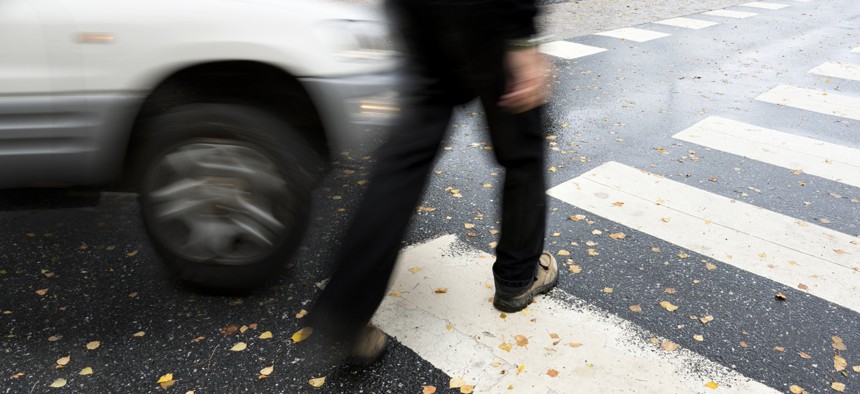America Saw a Historic Surge in Pedestrian Deaths Last Year

istock.com/PinkBadger
The fatality rate for people on foot who were struck by vehicles jumped 21%, despite the lowest driving activity in two decades, according to data from the Governors Highway Safety Association.
The fatality rate for pedestrians struck by cars spiked by 21% in 2020, the largest increase since the National Highway Traffic Safety Administration began tracking the statistic in 1975, according to a data analysis released Thursday by the Governors Highway Safety Association.
In 2019, 1.9 pedestrians were killed for every billion vehicle-miles traveled; in 2020, that number rose to 2.3—“the largest year-over-year increase ever recorded,” says the report. The increase occurred even as car usage dropped due to the pandemic. According to data from the Federal Highway Administration, driving in the United States dropped by 13.2% in last year, from 3.3 trillion vehicle-miles traveled in 2019 to 2.83 trillion in 2020—the lowest in two decades.
“Last year was filled with so much death and loss as Covid swept across the country,” Jonathan Adkins, executive director of the Governors Highway Safety Association, said in a statement. “As America gets vaccinated and returns to normal, we need to treat pedestrian safety like the public health emergency that it is.”
The report, an addendum to a similar analysis released earlier this year that calculated pedestrian deaths for the first six months of 2020, relies on preliminary counts of fatalities from state highway safety offices. Those projections will be finalized by the National Highway Traffic Safety Administration, likely sometime this summer.
According to the preliminary data, 6,721 pedestrians died in the United States in 2020, up from 6,412 in 2019—an increase of 309, or 4.8%. Thirty-one states and the District of Columbia saw increases in pedestrian fatalities, while 19 states had decreases, including 11—Utah, Idaho, Nebraska, Alabama, New York, Wyoming, Massachusetts, West Virginia, Delaware, Hawaii and Maine—with double-digit drops.
Warmer states with larger populations had the highest numbers of fatalities, led by California (1,026), Florida (729), Texas (723), Georgia (273) and North Carolina (263). By percentage, Kansas had the largest increase (174%, from 18 in 2019 to a projected 49 in 2020), followed by Vermont (159%, three to eight), Rhode Island (121%, eight to 18), and Alaska (116%, six to 13).
Some of those statistics are unsurprising, said Pam Shadel Fischer, senior director of external engagement for the Governors Highway Safety Association. Northeastern states, for example, tend to be more densely populated, leading to generally higher numbers of fatalities. But others are less clear.
“Kansas, for example, is a bit of an anomaly,” she said. “We’re not sure what happened there as it’s not necessarily one of the ones we would traditionally see.”
‘Weird Trends’
The overall results were somewhat surprising for researchers, Fischer said. When the Covid-19 pandemic began last year and states and localities issued stay-at-home orders, the initial expectation among experts was that pedestrian fatalities might decline due to lower numbers of cars on the roads.
“But about 30 days into it, we started getting calls and emails from our state highway safety offices telling us they were seeing some weird trends,” she said. “There were people driving at dangerous rates of speed and, in some states, they saw the number of crashes and fatalities going up.”
There are likely a number of factors contributing to that outcome, Fischer said. Throughout the pandemic, states reported higher numbers of speeding cars and people driving under the influence of drugs or alcohol, as well as greater numbers of drivers being ejected from their cars during crashes, suggesting an uptick in risky behavior in general. That, along with an influx of pedestrians using sidewalks and roadways to spend time outdoors and the country’s generally car-centric infrastructure, likely led to the spike, she said.
“When you factor in all these things, it’s kind of a perfect storm,” she said. “We have to understand that these are the factors we’re dealing with, and really look at them, because these are the things we’re going to have to fix.”
Some Bright Spots
The report also contained several bright spots, including Florida, which had one of the highest numbers of pedestrian fatalities in the country but reported a 2% decrease from 2019 (745 to 729). That could be partially due to decreased tourism during the pandemic, but is likely also the result of years of statewide investment in pedestrian safety, including a pedestrian and bicycle strategic safety plan and a comprehensive educational campaign.
“Florida, in particular, has been working diligently on this issue,” Fischer said. “They’ve been throwing the kitchen sink at this problem for more than a decade and really working hard through a variety of countermeasures to get the numbers down.”
To lower pedestrian fatalities, states should consider a variety of tactics, she said, including “high-visibility enforcement” for reckless driving, automated enforcement for speeding, and dedicated space for walkers and bikers.
“We all want the same thing,” she said. “We all agree that zero is the only acceptable number of pedestrian fatalities, and we need to use those countermeasures that work, as well as new and emerging technologies, to get the numbers down.”
Kate Elizabeth Queram is a senior reporter for Route Fifty and is based in Washington, D.C.
NEXT STORY: Cities, States Providing Legal Aid to Stave off Post-Covid Evictions





